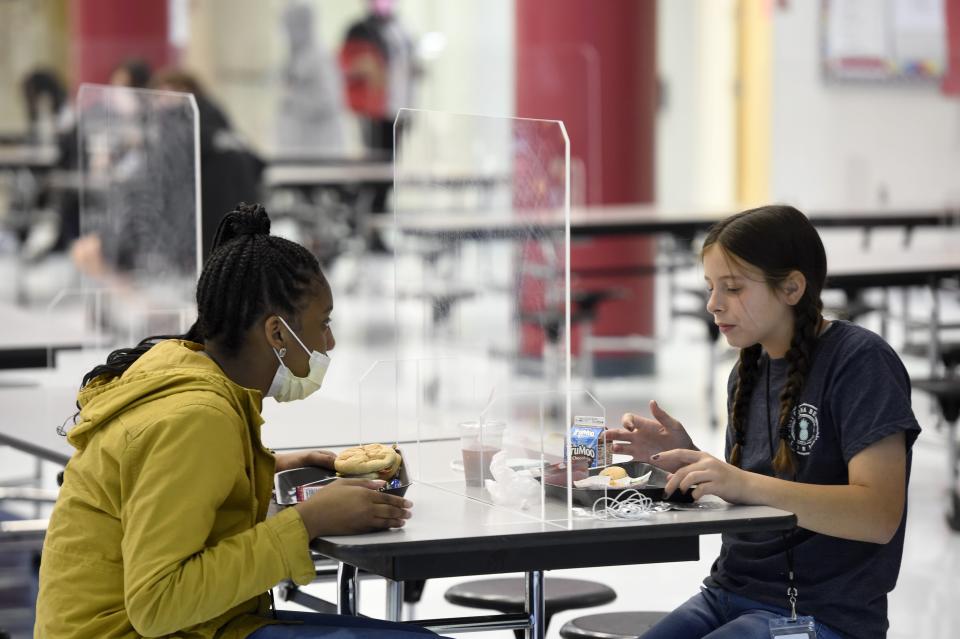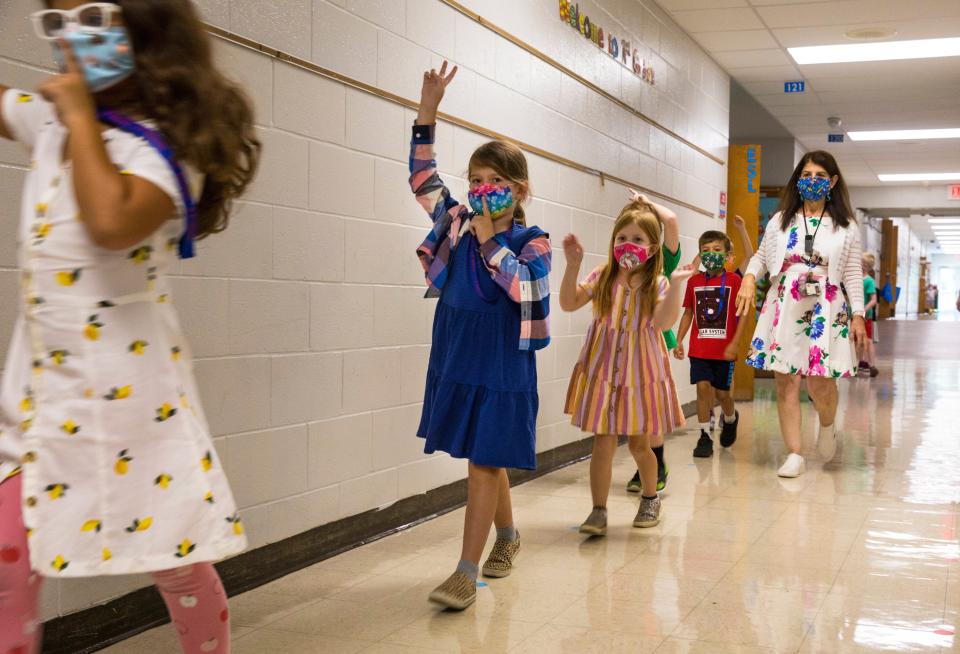Did America’s schools open safely? We crunched the latest data on COVID-19 and kids.
America’s schoolchildren are weathering a third year of pandemic education, and most are in class together again instead of isolated at home.
Grown-ups battled over the right way to safely open schools amid a surge of a more transmissible variant of the COVID-19 virus. States and districts took wildly different approaches. Some strictly required masks; others banned mask mandates. Some states let districts decide.
Positive virus cases, quarantines and school closures sent kids back home in the early weeks of the fall semester, sometimes repeatedly. Millions of others remained in class.
Was school reopening a success? And what approach worked best?
Those are hard questions to answer, because it's difficult to isolate the effects of in-person school.
“Schools are intertwined with everything that goes on in the community … just like the pieces of a machine,” said Doug Harris, an economist at Tulane University who’s studied the effects of school reopenings on COVID-19 hospitalizations.
Related video: Schools, parents, officials clash over back-to-school COVID restrictions
Kid vaccines are coming: Don’t miss an update with the Coronavirus Watch newsletter.
The virus spreads at different rates in different communities, and vaccination rates, mask wearing and rules for behavior all play a role. School reopenings triggered changes in social behavior and health practices that influenced community spread, Harris said.
Many children were tested for the coronavirus more once they returned to school. Many parents returned to offices. Taken together, that meant more infections were captured that may have otherwise run their course undetected or unlogged.
“The increases that you were seeing in school-aged groups, what was happening is you had so many kids quarantined and parents were getting them tested," said Jason Salemi, an epidemiologist at the University of South Florida. "You were just detecting a higher proportion of the cases that were out there.”
The highly contagious delta variant of the coronavirus was already surging as school started, further complicating the picture.
Another challenge: Glaring holes in information about what's happening in certain communities. Some states have not reported all child deaths from COVID-19. Many districts decline to publicly report COVID-19 cases or quarantines.
But data from several sources can help us draw some conclusions about school reopening decisions in the COVID-19 era. Now that the back-to-school season is over and before the arrival of winter – when people will gather indoors again, and flu and coronavirus cases may spike – now is an opportune time to assess what happened.
Here are three ways to judge whether schools opened successfully.
Confused about kids and COVID-19? The American Academy of Pediatrics has answers.
Schools stayed open
The back-to-school season looked like it was headed for disaster. By early September, more than 1,000 schools had closed because of high numbers of students or staff in COVID-19 quarantines, according to data from Burbio, a company tracking districts’ responses to the pandemic.
Most of those schools have reopened because of increased COVID-19 protocols or the waning prevalence of the delta variant. The majority of students are in classrooms full time, regardless of their school’s mask or vaccine policy.
That’s good for students’ mental and social health – and crucial for their learning.
A total of 2,176 schools have partially or fully closed at some point this school year, or about 2% of the roughly 100,000 K-12 schools in America, according to an analysis of Burbio data as of Oct. 20. Almost 1 million students were affected by these closures. (The data doesn’t account for all the students who quarantined while their schools remained open and may be an undercount in districts that do not share data publicly.)
.oembed-frame {width:100%;height:100%;margin:0;border:0;}
Did schools lead to an increase in COVID-19 cases?
Many kids who get COVID-19 don’t need to go to a hospital. Many don’t even have symptoms, though long-term effects are unclear.
COVID-19 case counts among kids spiked after their schools reopened. Data shows the growth rate for each state’s school-age kids was higher than among adults. (School start dates vary from district to district; for each state, USA TODAY used the start date of its largest school district.)
.oembed-frame {width:100%;height:100%;margin:0;border:0;}
Doctors point to the start of school as the main cause of the surge in pediatric cases.
"Cases didn’t go up so much with the delta variant," said David Buchholz, a professor of pediatrics at Columbia University's Irving Medical Center. "They increased when school went back into session."
Bryan Jarabek, a physician and chief medical informatics officer at M Health Fairview, saw the same trend in Minnesota. "It started right when we started school."
Nationwide, cases in children grew by 129% in the six weeks after schools opened compared with the same period before classes started, according to a USA TODAY analysis of data from the Centers for Disease Control and Prevention.

Masks, vaccines mattered
Even though most states’ back-to-school seasons brought a spread in COVID-19, some states appear to have reopened schools more safely than others, based on child hospitalization data.
Pediatric hospitalization rates were generally far lower in states with high numbers of vaccinated children. After all, states with more vaccinated people are likely to see less virus transmission, experts said.
.oembed-frame {width:100%;height:100%;margin:0;border:0;}
Masks seemed to make a difference in case growth. The start of school was followed by faster COVID-19 growth in kids versus adults in most states, but the school effect tended to be more pronounced in places that banned schools from enforcing mask mandates or gave districts the ability to choose.
.oembed-frame {width:100%;height:100%;margin:0;border:0;}
This analysis has limits. The same anti-mask-mandate states that saw the biggest pediatric surges also had lower vaccination rates at all ages. In other words, it's hard to separate the two effects.
“Having a low vaccination rate was associated with greater hospitalizations, and having no mask was also associated with greater hospitalizations,” said Julie Swann, a professor at North Carolina State University who has advised school boards and health departments on the spread of COVID-19 in schools.
Most states had a surge in pediatric hospitalizations tied to schools reopening, especially states that barred mask mandates. Together with the trend in COVID-19 cases, that suggests schools contributed to the spread.
.oembed-frame {width:100%;height:100%;margin:0;border:0;}
Even states that mandated masks had bursts in pediatric COVID-19 cases and hospitalizations linked to the start of school.
"Just having a mandate didn't mean masks were worn or actually enforced," said Jennifer Nuzzo, an epidemiologist at Johns Hopkins University who studies global health security policy. "This is why people have called for clinical trials to be done. But even mentioning that makes people want to fight."
.oembed-frame {width:100%;height:100%;margin:0;border:0;}
.oembed-frame {width:100%;height:100%;margin:0;border:0;}
Florida: A case study
Finally, let’s take a deep dive into a state that’s gotten a lot of attention for its school reopenings: Florida.
Last summer, Gov. Ron DeSantis, a Republican, signed an executive order banning schools from requiring masks. Several districts flouted the order, and a court ruling in August put it on hold. In September, an appeals court ruled the ban on mask mandates could continue.
Amid this back-and-forth legal battle, a dozen or so Florida school boards have continued to defy the ban and require masks.
The inconsistencies in school reopening approaches across the state muddy the picture of how its fall semester has fared.
Zoom in on specific districts – some that required masks and others that didn’t – and patterns emerge.
Nikki Fried, Florida’s agriculture commissioner – a Democrat who holds an independently elected position on the state’s executive cabinet – released an analysis of district COVID-19 data in an effort to better understand the impact of school mask policies. The numbers, released in early October, come with caveats. Fried, who is running for governor in 2022, had to rely on publicly available data because the state’s Health Department, she said, refused to release complete numbers on pediatric hospitalizations and deaths.
Still, they’re telling: In districts such as Broward and Miami-Dade that began the school year with mask requirements, per capita COVID-19 case rates among students were 2.6 times lower than in districts that made masking optional. School districts without mask requirements had nearly twice as many student COVID-19 cases than districts that required masks.
.oembed-frame {width:100%;height:100%;margin:0;border:0;}
Contact Erin Richards at (414) 207-3145 or erin.richards@usatoday.com. Follow her on Twitter at @emrichards. Contact Alia Wong at (202) 507-2256 or awong@usatoday.com. Follow her on Twitter at @aliaemily. Contact Aleszu Bajak at (646) 543-3017 or abajak@usatoday.com. Follow him on Twitter at @aleszubajak.
This article originally appeared on USA TODAY: COVID cases in kids: Did school make pandemic worse? Do vaccines work?

 money
money 
